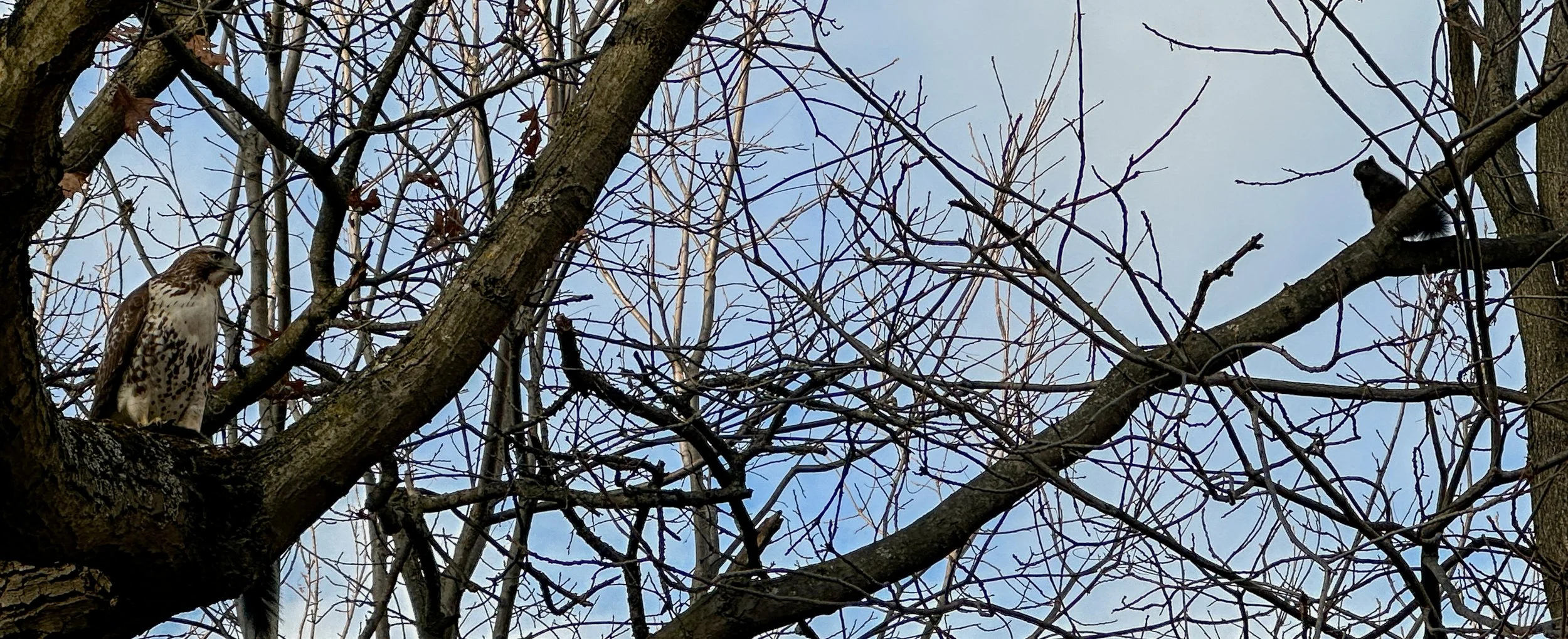The Hawk and the Squirrel
On a casual walk through High Park this week, I came upon a familiar scene: a loose group of dog walkers and pedestrians, heads all tilted up to the same nearby tree.
High Park is home to Hawk Hill, an urban monitoring station catching raptors as they head South for the winter. Between September 1st and November 30th, officials and volunteers count passing birds daily.
High Park’s hill turns out to be a great spot to spot them thanks to Lake Ontario. The birds hit the intimidating expanse of water on their way south and veer westward*, funnelling them past the park. The hill provides an unobstructed view.
If you want, you can check out the hard numbers here.
So back to us on our walk, it was little surprise that, once we’d triangulated the upward gazes of that small group, they converged on a red-tailed hawk.
A red-tailed hawk with one very dead eastern grey squirrel under its talons. The hawk wasn’t eating yet - wasn’t doing much of anything, aside from casting its darting gaze at the small crowd below… and occasionally at a second eastern grey squirrel, who couldn’t seem to leave it alone.
This second squirrel was hopping between branches on the same or nearby trees. It seemed agonized by indecision, darting perilously close to the predator, then shying back, seeming to give up entirely before returning to the branch.
Odd, to say the least. It immediately had me trying to apply some sort of behavioural logic to the situation.
Anthropomorphism being as strong a pull as always, my first thought was that I was seeing a mated pair. The hawk had killed one, the other was stuck between the instinct to approach its mate and the instinct to keep far away from the hawk.
But that’s a human brain thinking. Eastern grey squirrels don’t form strong mated pairs. There’s no reason to think that one would be compelled to such danger just to reunite. But if that drive didn’t conveniently explain the borderline-suicidal behaviour, what did?
There are actually a few options for why an eastern grey squirrel would chance a close encounter with a red-tailed hawk. Funnily enough, they don’t actually have anything to do with that second dead squirrel.
This could have been territorial. Eastern grey squirrels may not form strong pair-bonds, but they definitely have a strong sense of territory and will defend it aggressively. Maybe that territorial drive was almost exactly equal to the mental alarm bells saying ‘don’t get close to a hawk’.
Squirrels also exhibit mobbing behaviour, when a group of prey animals band together to chase a predator out of the area. This tends to occur when the predator isn’t actively engaged in the hunt (like this hawk) and when there’s a big enough group of prey animals to feel like a threat. The squirrel might be doing a ‘botched mob’, being by itself and without the backup muscle to make a real impression on the hawk. It kept chancing at mobbing behaviour but couldn’t quite commit or ruffle the hawk’s feathers any.
And then there is simply spatial conflict! Rather than assign any complex behaviours and thought processes to the squirrel, what we were watching could have been more akin to a ‘glitch’. The squirrel wanted to get somewhere past the hawk, and kept being stuck on whether it was safe to do so. This, compounded by the fact that the hawk was stalk-still and making no threatening or predatory movements, could have tipped the squirrel’s behavioural calculus to that knife-edge between ‘go through’ and ‘too dangerous’.
Eventually we left the two of them in that stand-off, and by the time we were on our way back out and passed the same tree, both (or, all three) were gone.
It was only the next day that another clue popped into my head. A ‘curious incident of a squirrel in the daytime’: the squirrel had been silent. And if you live anywhere with a decent population of eastern grey squirrels, you know that they don’t tend to keep their opinions to themselves. If this had been territorial or mobbing behaviour, you’d think it would come with territorial or alarm calls.
Where does that leave us? Nowhere certain, and maybe back to tragedy. It’s not a requirement that territorial or mobbing behaviour must include vocalizations.
But while eastern grey squirrels don’t form strong mating bonds, the parent-child relationship is much closer, at least for the first few months of life. We couldn’t tell from our vantage point the relative ages of the two squirrels but it is possible we weren’t seeing the tragic rending of a mated pair, rather the tragic rending of a parent-child pair. Whether parent or child was under the hawk’s talons, that might compel the survivor to be caught between wanting to get closer and escaping to safety.
Sorry. To be clear, that is still speculation. An unusual scene, a bit of perplexing behaviour, and not enough evidence in any direction to say for sure. So if we want to say that the squirrel was just testing its luck on bullying a red-tailed hawk… I think that’s OK too.
But if anyone has any insights - let me know!
*It’s not simply the challenge of crossing the lake that makes the raptors change course. They conserve energy during long flights by riding ‘thermals’, upward currents of warm air that can keep them aloft without flapping their wings. These thermals occur when sunlight hits and warms the land. Raptors depend on taking advantage of thermals to be able to make long migratory flights without completely exhausting themselves. And the thermal effect doesn’t occur over water. So it’s not just a challenge for them to cross the lake, it could be deadly.



